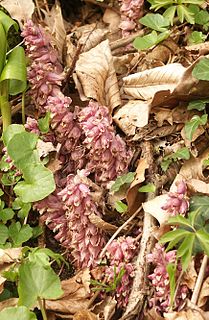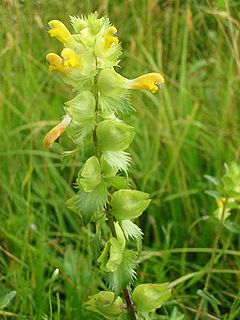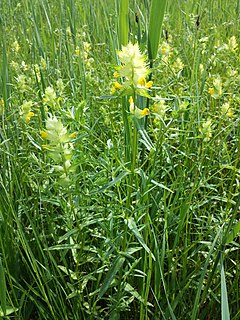
Lathraea (toothwort) is a small genus of five to seven species of flowering plants, native to temperate Europe and Asia. They are parasitic plants on the roots of other plants, and are completely lacking chlorophyll. They are classified in the family Orobanchaceae.
Rattlebox is a common name for several plants which have inflated fruits in which the seeds may rattle:

Rhinanthus minor, known as Yellow Rattle, is a herbaceous wildflower in the genus Rhinanthus in the family Orobanchaceae. It is a native species in Europe, Russia and western Asia. An annual plant, Yellow Rattle grows up to 10–50 centimetres tall, with upright stems and opposite, simple leaves. The fruit is a dry capsule, with loose, rattling seeds.

Orobanchaceae, the broomrapes, is a family of mostly parasitic plants of the order Lamiales, with about 90 genera and more than 2000 species. Many of these genera were formerly included in the family Scrophulariaceae sensu lato. With its new circumscription, Orobanchaceae forms a distinct, monophyletic family. From a phylogenetic perspective, it is defined as the largest crown clade containing Orobanche major and relatives, but neither Paulownia tomentosa nor Phryma leptostachya nor Mazus japonicus.

Melampyrum is a genus of about 20 species of herbaceous flowering plants in the family Orobanchaceae known commonly as cow wheat. They are native to temperate regions of the Northern Hemisphere. They are hemiparasites on other plants, obtaining water and nutrients from host plants, though they are able to survive on their own without parasitising other plants.

Rhinanthus (rattle) is a genus of annual hemiparasitic herbaceous plants in the family Orobanchaceae, formerly classified in the family Scrophulariaceae. The genus consists of about 30 to 40 species found in Europe, northern Asia, and North America, with the greatest species diversity in Europe.

A flower garden or floral garden is any garden where flowers are grown and displayed.

North Meadow, Cricklade is a hay meadow near the town of Cricklade, in Wiltshire, England. It is 24.6 hectares in size. It is a traditionally managed lowland hay-meadow, or lammas land, and is grazed in common between 12 August and 12 February each year, and cut for hay no earlier than 1 July. This pattern of land use and management has existed for many centuries and has resulted in the species rich grassland flora and fauna present on the site.

Rhinanthus angustifolius, the narrow-leaved rattle or greater yellow-rattle, is a plant species of the genus Rhinanthus. It is an annual wildflower native to temperate grasslands in much of Europe, and north and central Western Asia. The yellow flowers are mostly visited by bumblebees.

Cerastis rubricosa, the red chestnut, is a moth of the family Noctuidae. The species was first described by Michael Denis and Ignaz Schiffermüller in 1775. It is found in most of Europe, east through the temperate regions of the Palearctic east to Japan. In the north it is found just north of the Arctic Circle. Southward it is found up to the Mediterranean Basin and Turkey.
A facultative parasite is an organism that may resort to parasitic activity, but does not absolutely rely on any host for completion of its life cycle.

Apteropeda orbiculata is a species of beetle in the Chrysomelidae family that can be found on the British Isles, Denmark, France, Germany, Northern Spain, the Netherlands, Western Poland and Western Ukraine. It is black coloured, but can also be green.

Viidumäe Nature Reserve is a nature reserve situated on Saaremaa in western Estonia, in Saare County.

Endothenia marginana, the downland marble, is a moth of the family Tortricidae. It was described by Adrian Hardy Haworth in 1811. It is found in almost all of Europe and across the Palearctic.

Rhinanthus osiliensis, in English known by the common name Saaremaa yellow rattle, is a flowering plant in the genus Rhinanthus in the family Orobanchaceae. It is endemic to the Estonian island Saaremaa in the Baltic Sea. Plants growing on the Swedish island Gotland have been ascribed to R. osiliensis, too, but genetic analyses have not supported this hypothesis.

Rhinantheae is a tribe with less than 20 genera of herbaceous plants in the family Orobanchaceae.

Rhynchocorys is a small genus of flowering plants belonging to the family Orobanchaceae, formerly classified in the family Scrophulariaceae. It is native to Europe, Morocco and Algeria.

Rhinanthus serotinus is a species of flowering plant belonging to the family Orobanchaceae.
Duncan Drummond Cameron is a British microbiologist and Professor of Plant and Soil Biology at the University of Sheffield. His research considers multiomics approaches to understand the interactions between soil microbes and plant nutrition. Alongside his research, Cameron works in science policy, and was involved with the 2015 United Nations Climate Change Conference.

Rhinanthus glacialis, commonly known as the aristate yellow rattle or glacier rattle, is a herbaceous plant species in the family Orobanchaceae, formerly classified as a member of the family Scrophulariaceae. This European species is primarily inhabiting the Central Europe.
















